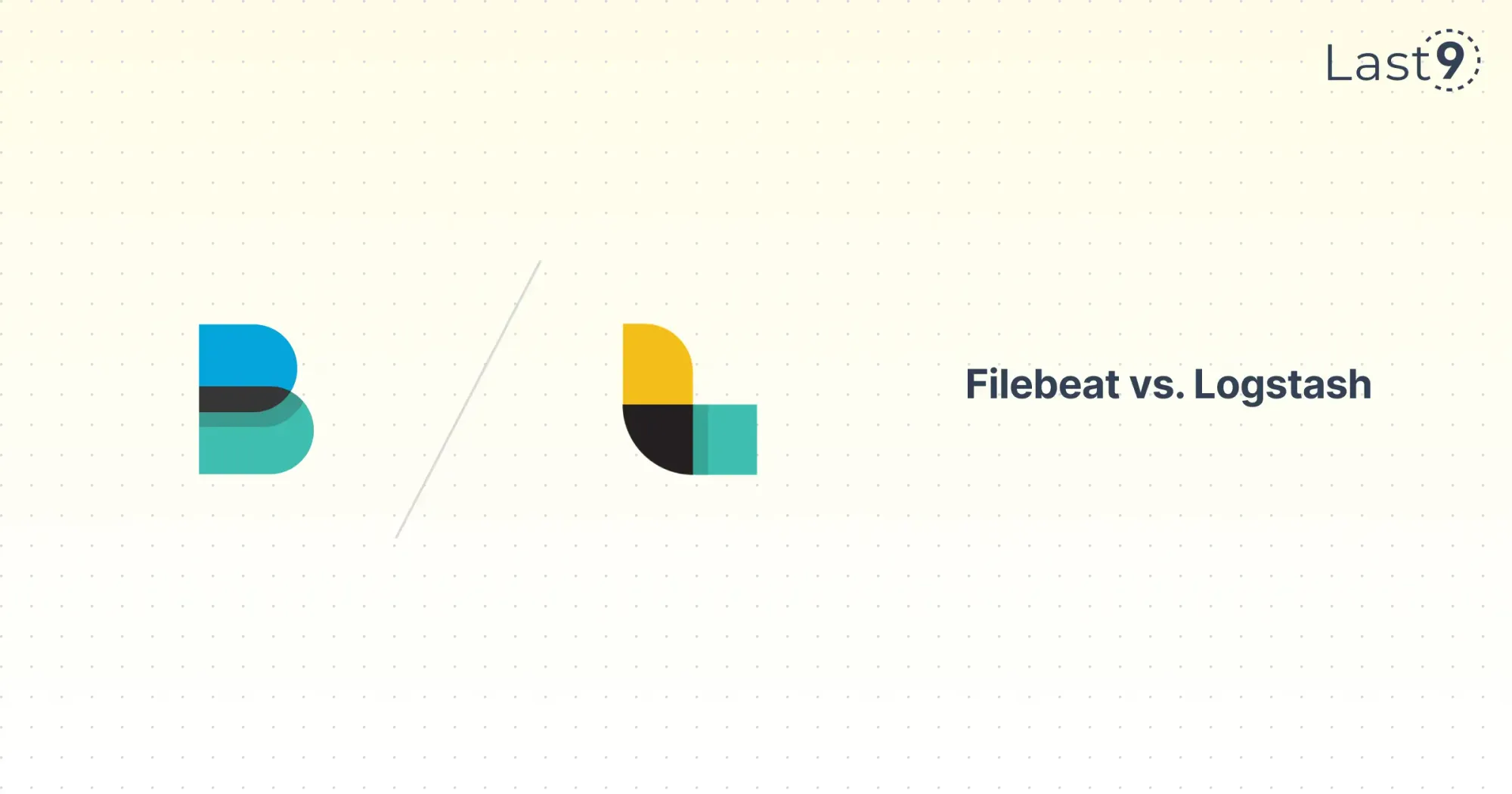Modern infrastructures like Kubernetes, IoT, and cloud-native architectures are log-generating machines. These logs are treasure troves of insights, crucial for identifying performance bottlenecks, diagnosing errors, and ensuring compliance. To tap into this goldmine, you need efficient tools for managing, processing, and analyzing logs.
Fluentd and Fluent Bit, are the two log management tools from the CNCF ecosystem. While they share a family name, they cater to different needs.
Fluentd vs Fluent Bit
Here’s a quick snapshot of these tools:
Log Management Fundamentals
Log management follows a basic pipeline:
- Collection
- Processing
- Routing
- Storage
Both Fluentd and Fluent Bit implement this pipeline using the concept of event streams. An event stream represents a continuous flow of log data with timestamps and metadata.

Core Concepts
Unified Logging Layer
Both tools implement a "unified logging layer" which:
- Standardizes log data format
- Provides consistent processing interfaces
- Enables vendor-agnostic log routing
Event Structure
{
"time": "2024-03-15 10:30:45",
"tag": "app.production.web",
"record": {
"level": "error",
"message": "Connection refused",
"source": "web-server-01"
}
}Architectural Comparison
Fluentd Architecture
Components:
- Input Plugin (Source)
- Parser Plugin
- Filter Plugin
- Buffer
- Output Plugin
The architecture follows a modular design pattern where each component is isolated and replaceable.
# Basic Fluentd Component Flow
Input → Parser → Filter → Buffer → OutputFluent Bit Architecture
Components:
- Input
- Parser
- Filter
- Output
Fluent Bit uses a lighter architecture with components compiled directly into the binary.

What’s the Difference?
Purpose
- Fluentd: The Swiss Army knife of logging, handling everything from parsing to enrichment and routing.
- Fluent Bit: A scalpel, designed for quick, efficient log collection and forwarding.
Architecture
- Fluentd: Ruby-based design allows for incredible customization through plugins but comes at the cost of higher resource consumption.
- Fluent Bit: Built-in C, offering a lightweight alternative optimized for speed.
Performance
- Fluent Bit: Excels in speed and resource efficiency, particularly in Kubernetes or edge environments.
- Fluentd: Focuses on features over performance, making it a better choice for centralized systems.
Fluentd and Fluent Bit Use Cases
Use Cases for Fluentd
Fluentd is a powerhouse when your goal is centralized log processing with advanced features. Real-world examples include:
- Banking and Finance: Monitor transactional logs, enrich them with metadata, and forward them to Elasticsearch for fraud detection.
- E-commerce Platforms: Aggregate logs from multiple servers to track user behavior and identify purchase trends.
- Media and Entertainment: Parse and normalize logs from streaming services to optimize performance during high-traffic events.
Use Cases for Fluent Bit
Fluent Bit thrives in environments where agility, speed, and resource optimization are non-negotiable.
- IoT Deployments: Think of remote sensors or Raspberry Pi devices that need lightweight processing.
- Kubernetes Clusters: Deploy Fluent Bit as a DaemonSet to collect logs from all pods while consuming minimal resources.
- Gaming Applications: Process logs in real-time to monitor latency or user activity during live events.

Key Features That Set Them Apart
Integrations with Popular Tools
Both tools shine when paired with other monitoring and observability platforms:
- Grafana and Loki: Fluent Bit’s native integration simplifies log forwarding for real-time dashboards.
- OpenTelemetry: Fluentd works as a bridge between logs, traces, and metrics, enabling holistic observability.
- Kafka: Both tools can route logs to Kafka for scalable data processing pipelines.
- Last9: Last9 integrates well with both Fluentd and Fluent Bit, helping you take control of your logs and metrics in a way that's easy to manage. With Last9, you can simplify your observability and performance monitoring without hassle.

Advanced Tips and Unique Scenarios
Combining Fluentd and Fluent Bit
Why choose one when you can use both? Here’s how:
- Fluent Bit: Deployed close to the source (e.g., Kubernetes pods) for lightweight log collection.
- Fluentd: Acts as the central processing hub, enriching and routing logs to storage or analysis platforms like ClickHouse.
Deployment Scenarios
Centralized Logging in Kubernetes
- Deploy Fluent Bit as a DaemonSet for efficient pod-level log collection.
- Forward logs to Fluentd for enrichment and aggregation.
IoT Ecosystems
- Use Fluent Bit to process logs locally on edge devices.
- Send processed logs to Fluentd or cloud storage for analysis.

Troubleshooting Tips for Fluentd and Fluent Bit
No tool is without quirks. Here’s how to handle common challenges:
High Resource Consumption in Fluentd
- Problem: Memory usage spikes with plugins like in_tail.
- Solution: Optimize buffer settings or split workloads using Fluent Bit.
Dropped Logs in Fluent Bit
- Problem: Buffer overflows can lead to lost logs.
- Solution: Increase buffer limits or enable disk-based buffering.
Slow Log Parsing
- Problem: Complex regex patterns in Fluentd plugins.
- Solution: Simplify patterns or pre-process logs using Fluent Bit.
Hidden Gems and Features
Fluentd
- Use plugins like record_transformer to add fields dynamically.
- Leverage Fluentd’s advanced routing to send logs to multiple destinations.
Fluent Bit
- Optimize configurations using parameters like flush intervals for better throughput.
- Implement Lua scripts for custom log transformations.
Implementation Guide for Log Collection and Forwarding
Basic Setup
Fluentd Configuration
# Simple log collection and forwarding
<source>
@type tail
path /var/log/app/*.log
tag app.*
<parse>
@type json
</parse>
</source>
<match app.**>
@type elasticsearch
host elasticsearch.local
port 9200
</match>- <source>: Collects logs from
/var/log/app/*.logand parses them as JSON. - <match>: Forwards logs with the
app.*tag to an Elasticsearch instance atelasticsearch.local:9200.
Fluent Bit Configuration
[INPUT]
Name tail
Path /var/log/app/*.log
Tag app.*
Parser json
[OUTPUT]
Name es
Match app.*
Host elasticsearch.local
Port 9200- [INPUT]: Reads logs from
/var/log/app/*.logand parses them as JSON. - [OUTPUT]: Sends logs with the
app.*tag to Elasticsearch atelasticsearch.local:9200.

Performance Considerations
Memory Management in Fluentd
<system>
# Configure Ruby GC
<workers>
gc_interval 100 # GC interval for each worker
</workers>
</system>- <system>: Configures Ruby's garbage collection (GC) for Fluentd.
- gc_interval: Sets the GC interval to control memory cleanup and avoid excessive memory usage in each worker.
Memory Management in Fluent Bit
[SERVICE]
# Static memory chunks
Mem_Buf_Limit 5MB- [SERVICE]: Configures memory settings for Fluent Bit.
- Mem_Buf_Limit: Limits the memory buffer to 5MB to prevent excessive memory use.
Practical Use Cases for Fluentd and Fluent Bit
Kubernetes Logging
Kubernetes generates logs at three levels:
- Container logs
- Node logs
- Cluster events
Implementation:
apiVersion: v1
kind: ConfigMap
metadata:
name: fluent-bit-config
data:
fluent-bit.conf: |
[INPUT]
Name tail
Path /var/log/containers/*.log
Parser docker
Tag kube.*Input Section: Fluent Bit collects logs from Kubernetes container logs using the tail input plugin. It parses the logs using the docker parser and tags them with kube.*.

Multi-tenant Log Management
Multi-tenancy requires:
- Log isolation
- Resource quotas
- Access control
Implementation:
# Fluentd multi-tenant configuration
<match tenant.*.*>
@type copy
<store>
@type elasticsearch
host elasticsearch.local
port 9200
index_name ${tag[0]}
type_name ${tag[1]}
</store>
</match>Match Section: Fluentd routes logs for each tenant using the copy plugin. Logs are stored in Elasticsearch, with separate indices for each tenant (${tag[0]} for the tenant and ${tag[1]} for the specific service type). This ensures log isolation per tenant.
Technical Comparison
Effective Implementation Strategies for Fluentd and Fluent Bit
Buffer Management
- Purpose: Buffers store logs temporarily to prevent data loss during network issues or backend downtime.
- Implementation: The buffer uses a file type, stores logs at a specific path, flushes every 60 seconds, and retries up to 5 times if an issue occurs.
<buffer>
@type file
path /var/log/fluentd/buffer
flush_interval 60s
retry_max_times 5
</buffer>Resource Allocation
Buffer size is calculated based on log entry size, events per second, and flush interval to ensure proper memory usage.
Buffer Size = (Log Entry Size × Events per Second × Flush Interval)- Log Entry Size: The average size of each log entry (in bytes).
- Events per Second: The number of log entries generated per second.
- Flush Interval: How often the buffer is flushed (in seconds).
This formula helps determine how much memory should be allocated to handle logs efficiently without losing data.

Troubleshooting Framework
- Data Flow: Check the input, parser, buffer, and output to verify logs are correctly processed.
- System Resources: Monitor CPU, memory, disk I/O, and network to ensure smooth operation.
Security Considerations
- Authentication: Uses TLS/SSL for secure communication, with authentication and role-based access control (RBAC) to secure log data.
- Example TLS Config: Fluent Bit’s TLS configuration ensures encrypted communication using certificates.
# Fluent Bit TLS Configuration
[INPUT]
Name forward
Listen 0.0.0.0
Port 24224
TLS on
TLS.verify on
TLS.cert_file /etc/fluent-bit/cert.pem
TLS.key_file /etc/fluent-bit/key.pem- Name: Specifies the input plugin. In this case, it’s the
forwardplugin that listens for log data from other sources. - Listen: Sets the IP address on which Fluent Bit will listen for incoming data.
0.0.0.0means all available interfaces. - Port: The port number to listen on for incoming data (24224 is the default for Fluent Bit's
forwardinput). - TLS: Enables TLS encryption for secure data transmission.
- TLS.verify: Ensures that the incoming data connection is verified.
- TLS.cert_file: Path to the TLS certificate for Fluent Bit.
- TLS.key_file: Path to the TLS key used for encryption.

Monitoring and Alerting
- Health Metrics: Fluent Bit/Fluentd exposes metrics (e.g., Prometheus) to track performance, resource usage, and health.
[SERVICE]
HTTP_Server On
HTTP_Listen 0.0.0.0
HTTP_Port 2020
[FILTER]
Name prometheus
Match *- [SERVICE]: Defines service-level settings for Fluent Bit.HTTP_Server: Enables the HTTP server for exposing metrics.HTTP_Listen: Specifies the IP address for the server to listen on (
0.0.0.0means it will accept connections from any interface).HTTP_Port: Sets the port (2020) on which Prometheus metrics are exposed. - [FILTER]: Configures a filter to modify or enhance the log data.Name: Specifies the filter plugin to use; in this case,
prometheusfor exporting metrics.Match: Defines which log data should be passed through the filter. The*means all incoming logs will be processed by the Prometheus filter.
This setup exposes Fluent Bit metrics to Prometheus on port 2020, allowing Prometheus to scrape performance and health metrics from Fluent Bit for monitoring purposes.
- Alert Integration: Set up alerts for failures, thresholds, and routing to alert managers for proactive management.
Scaling Strategies
- Horizontal Scaling: Use load balancing and clustering for scalability and high availability.
- Vertical Scaling: Adjust resource allocation to improve performance; optimize buffer sizes for better throughput.

Data Format Handling
- Supported Formats: Fluent Bit/Fluentd handles multiple formats like JSON, binary, and custom formats.
- Example Parser Config: Fluentd uses regular expressions to parse logs with custom time formats.
<parse>
@type regexp
expression /^(?<time>\d{4}-\d{2}-\d{2} \d{2}:\d{2}:\d{2}) (?<level>\w+) (?<message>.*)$/
time_format %Y-%m-%d %H:%M:%S
</parse>- @type regexp: Specifies that a regular expression (regexp) is used to parse log data.
- expression: Defines the regular expression pattern used to extract specific fields from the log data:
(?<time>\d{4}-\d{2}-\d{2} \d{2}:\d{2}:\d{2}): Captures the timestamp in the formatYYYY-MM-DD HH:MM:SS.(?<level>\w+): Captures the log level (e.g.,INFO,ERROR).(?<message>.*): Captures the actual log message. - time_format: Defines the format in which the time is extracted, ensuring it matches the log format (
%Y-%m-%d %H:%M:%SforYYYY-MM-DD HH:MM:SS).
This configuration enables Fluentd to parse logs with a specific format and extract useful fields (timestamp, log level, and message) for further processing or routing.
Backup and Recovery
- Backup Strategies: Ensure configuration, buffer, and log data are backed up, with clear recovery procedures in case of failure.
Cost Analysis
- Resource Costs: Analyze CPU, memory, storage, and bandwidth consumption.
- Operational Costs: Track maintenance, monitoring, and support need to calculate overall expenses.

Performance Testing
- Benchmark Methodology: Perform load tests to measure throughput, latency, and resource consumption, and analyze scalability limits.
scenario:
throughput: 10000 events/sec
duration: 1h
concurrent_inputs: 100
message_size: 1KB- Test Configuration: Simulate high event throughput to evaluate performance under load.
Migration Guidelines
- Migration Planning: Assess resource requirements, timelines, and risks. Ensure smooth migration with data validation and cutover strategies.
Version Compatibility
- Version Matrix: Review supported versions, deprecations, and upgrade paths.
- Compatibility Issues: Address known limitations and workarounds during migration.

Community and Support
- Community Resources: Access forums, plugins, documentation, and training.
- Enterprise Support: Explore commercial support options, SLAs, and professional services.
Integration Patterns
- Common Architectures: Support standalone, hybrid, and multi-cluster setups, including cloud integration.
- Third-party Tools: Integrate with monitoring, alerting, data analysis, and visualization platforms.
Conclusion: Fluentd vs Fluent Bit – Which Is Right for You?
Choosing between Fluentd and Fluent Bit boils down to your use case:
- Pick Fluent Bit for lightweight, edge-level processing with minimal resource impact.
- Opt for Fluentd if your focus is on centralized log enrichment and complex pipelines.
In most setups, these tools work better together, creating a robust pipeline that handles logs efficiently from collection to storage.

At Last9, we believe observability should be easier. That’s why we’ve built a data warehouse that’s made to handle telemetry data (logs, traces, metrics, and events) at a massive scale.
We're here to give you more control and flexibility—without the vendor lock-in or sky-high prices.
If you want to understand more about it, schedule a demo or give it a try for free!
FAQs:
What are Fluentd and Fluent Bit?
- Fluentd: A log processor that aggregates, enriches, and routes logs to multiple storage destinations. It's a centralized solution designed for high customization and advanced pipelines.
- Fluent Bit: A lightweight log collector designed to work in edge environments and resource-constrained systems, focusing on log forwarding with minimal overhead.
How are Fluentd and Fluent Bit related?
Both tools are part of the Fluent ecosystem and are managed by the CNCF. Fluent Bit was developed as a lightweight version of Fluentd, optimized for resource efficiency while retaining core logging capabilities.
Which is better: Fluentd or Fluent Bit?
The choice depends on your use case:
- Use Fluentd if you need centralized log processing with advanced enrichment and routing capabilities.
- Use Fluent Bit for resource-efficient, edge-level log collection and forwarding.
Can I use Fluentd and Fluent Bit together?
Yes! A common setup involves deploying Fluent Bit at the log source to collect and forward logs efficiently, while Fluentd serves as the central processor to aggregate, transform, and store logs.
What are the key differences between Fluentd and Fluent Bit?
| Aspect | Fluentd | Fluent Bit |
|---|---|---|
| Resource Usage | Higher (due to Ruby architecture) | Lower (written in C) |
| Use Case | Centralized log processing | Lightweight log collection |
| Plugins | Over 1,000 plugins available | Fewer, optimized plugins |
Is Fluent Bit suitable for Kubernetes?
Yes, Fluent Bit is highly suitable for Kubernetes environments. It can be deployed as a DaemonSet to efficiently collect logs from all pods and forward them to a central destination like Fluentd or a logging platform.
Does Fluent Bit support log enrichment?
Fluent Bit supports basic log enrichment, such as adding metadata or labels. However, for complex enrichment tasks, Fluentd is the better choice.
What languages are Fluentd and Fluent Bit written in?
- Fluentd is written in Ruby, with some performance-critical parts in C.
- Fluent Bit is written entirely in C, making it lightweight and fast.
What are some alternatives to Fluentd and Fluent Bit?
Popular alternatives include:
- Logstash: A robust log processing tool.
- Graylog: A centralized logging solution.
- Promtail: Works with Loki for log aggregation.
Can Fluentd and Fluent Bit integrate with Grafana and OpenTelemetry?
Yes:
- Fluent Bit integrates with Grafana Loki for real-time log visualization.
- Fluentd supports OpenTelemetry for comprehensive observability across logs, metrics, and traces.
How do I decide which tool to deploy?
Consider these factors:
- Environment: For edge or resource-constrained environments, use Fluent Bit.
- Log Pipeline Complexity: For complex pipelines requiring transformation and routing, use Fluentd.
Are there any hidden costs with Fluentd or Fluent Bit?
Both tools are open source, so there are no direct licensing costs. However, resource usage (e.g., memory and CPU for Fluentd) and infrastructure costs (e.g., storage and network for logs) should be factored in.
What are the common challenges with Fluentd and Fluent Bit?
- Fluentd: High memory usage with plugins like
in_tail. - Fluent Bit: Risk of dropped logs if buffers overflow.
Can Fluent Bit handle logs in JSON format?
Yes, Fluent Bit can parse, process, and forward logs in JSON format. Its flexibility allows it to work seamlessly with structured data.















